The heart of the Atacama desert is the driest place on Earth. But that didn't prevent the first settlers of South America from setting up home there more than 12,000 years ago.
Michael Marshall
Source – http://www.newscientist.com/article/dn24082-early-south-americans-conquered-the-atacama-desert.html#.UhWtc5JM_wY
Aside from Antarctica, South America was the last continent that modern humans colonised, says Claudio Latorre of the Pontifical Catholic University of Chile in Santiago. The first settlers arrived from North America at least 14,000 years ago, but their route south is a mystery. Most researchers assume they travelled through fertile corridors, perhaps down the west coast where seafood was plentiful, at least until you hit the desert.
"Extreme environments, such as the Atacama, were naturally assumed to be barriers," says Latorre. "This was not the case."
Latorre and colleagues excavated a site called Quebrada Maní, which lies 85 kilometres inland and only receives rain a few times a century.
Digging on a low hill surrounded by arid valleys, they found stone tools, animal bones, sea shells and the remains of a fireplace.
How did these people survive in the Atacama? Most of the desert's core was just as harsh then as it is today. But the team found the remains of plants at the site, suggesting that the valleys had seasonal marshes that acted as oases, and which have since dried up. Nowadays, only a few hardy microbes live there, often underground.
If people did enter South America along its west coast, Quebrada Maní could have been an important pit stop for heading inland, says team member Calogero Santoro of the University of Tarapacá in Arica, Chile. "Certain features of the site seem to correspond to a base camp," he says.
"We need to think in terms of oasis hopping," agrees Silvia Gonzalez of Liverpool John Moores University in the UK. She has found similar archaeological sites in Mexican deserts where there were once oases. "These barren sites were not barren then."
If the settlers really were journeying between widely separated oases, they must have been skilled navigators. Gonzalez thinks their society was probably already quite sophisticated. "Even at this early stage, there was probably trade," she says, with distant settlements exchanging items like sea shells and volcanic glass.
Journal reference: Quaternary Science Reviews, DOI: 10.1016/j.quascirev.2013.06.008
Late Pleistocene human occupation of the hyperarid core in the Atacama Desert, northern Chile
Claudio Latorre, Calogero M. Santoro, Corresponding author contact information, Paula C. Ugald, Eugenia M. Gayo, Daniela Osorio, Carolina Salas-Egañ, Ricardo De Pol-Holz, Delphine Joly, Jason A. Rech
Abstract
Few archeological sites in South America contain uncontroversial evidence for when the first peopling of the continent occurred. Largely ignored in this debate, extreme environments are assumed either as barriers to this early wave of migration or without potential for past habitability. Here, we report on a rare 12–13 ka human occupation from Quebrada Maní (site QM12), a plantless, near rainless landscape (1240 m asl and 85 km from the Pacific Ocean) located in the hyperarid core of the Atacama Desert. This location harbored wetlands and riparian woodlands that were fed by increased rainfall further east in the central Andes during the latest Pleistocene. Excavations at QM12 yielded a diverse cultural assemblage of lithics, burned and cut bones, marine gastropods, pigments, plant fibers, and wooden artifacts alongside a prepared fireplace. Sixteen radiocarbon dates from site QM12 on charcoal, marine shells, animal dung, plant remains and wood reveal that the occupation took place between 12.8 and 11.7 ka. These results demonstrate that the Atacama Desert was not a barrier to early American settlement and dispersal, and provide new clues for understanding the cultural complexity and diversity of the peopling of South America during the Last Glacial–interglacial transition.
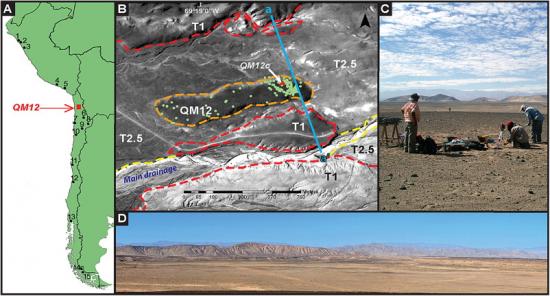
Fig. 1. Western South America and location of site Quebrada Maní 12. A. Early sites older than 12 ka: 1- Pampa de los Fósiles (Chauchat et al., 2004), 2- Huaca Prieta (Dillehay et al., 2012), 3- Guitarrero Cave (Jolie et al., 2011), 4- Quebrada Jaguay (Sandweiss et al., 1998), 5- Quebrada Tacahuay (deFrance and Umire, 2004), 6- Tuina Cave (Núñez et al., 2002), 7- La Chimba (Llagostera, 1979), 8- Tulán 109 (Núñez et al., 2002), 9- Salar de Punta Negra-1 (Grosjean et al., 2005), 10- Santa Julia (Jackson et al., 2007), 11- San Ramón (Salazar et al., 2011), 12- Tagua Tagua (Núñez et al., 1994), 13- Monte Verde (Dillehay, 2000), 14- Cueva Lago Sofía 1 (Massone, 2004), 15- Cueva Fell (Bird, 1988). B. Quebrada Maní floodpain with location of the Pleistocene terrace (T2.5, yellow dash) inset into the late Miocene T1 terraces (outlined in red dash) and active drainage, the a–a′ line corresponds to the cross-section shown in Fig. 3 (Image source: SAF 1:50,000 air photo). The QM12 site (orange dash) is mapped along with lithic concentrations and isolated artifacts (pale green dots) and excavation QM12c, (red dot). C. Photograph of site QM12 surface looking northeast. D. Panoramic view of the Quebrada Maní Pleistocene floodplain looking east toward Sierra Moreno (the photo was taken from site QM12c). (For interpretation of the references to color in this figure legend, the reader is referred to the web version of this article.)
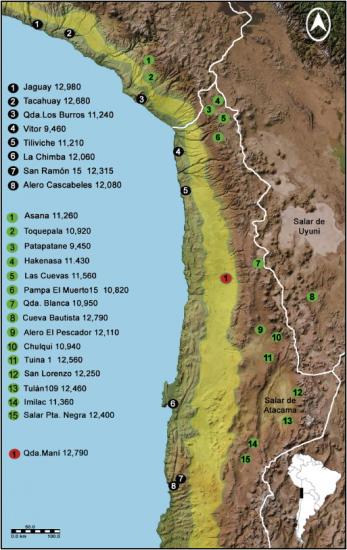
Fig. 2. Early archeological sites (with the oldest age of human occupation in calibrated 14C years BP) along the western Andean slope between 16° and 25°S. Dark dots: coastal sites, Green dots: sites located at elevations above 3000 m asl. Yellow area describes the extension of the Atacama Desert hyperarid core. Note that the QM site represents the first late Pleistocene (and oldest in northern Chile) site discovered within this extreme environment. (For interpretation of the references to color in this figure legend, the reader is referred to the web version of this article.)
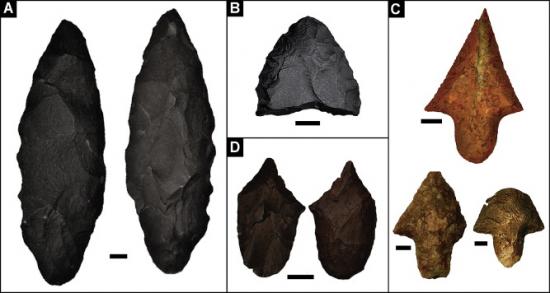
Fig. 4. Surface lithic tools from QM12 site. A. Thin, elongated bifacial tool; B. Naturally broken bifacial tool reworked in one margin as a burinant point, and as a side-scraper; C. Triangular stemmed projectile points that resemble “Las Cuevas-type”; D. “Patapatane” reworked projectile point. All scale bars are 2.5 cm.
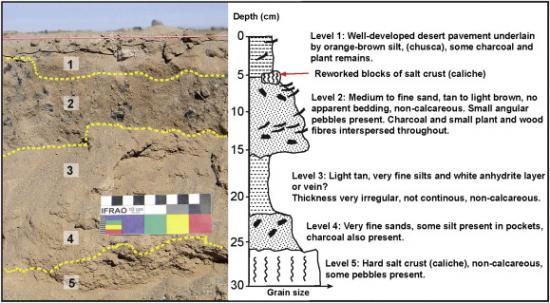
Fig. 5. Photograph and detailed stratigraphy of an exposed section along the southeast wall at QM12c. Note the abundance of charcoal fragments and plant remains in layers 2–4. Red string marks the 0 cm reference. (For interpretation of the references to color in this figure legend, the reader is referred to the web version of this article.)
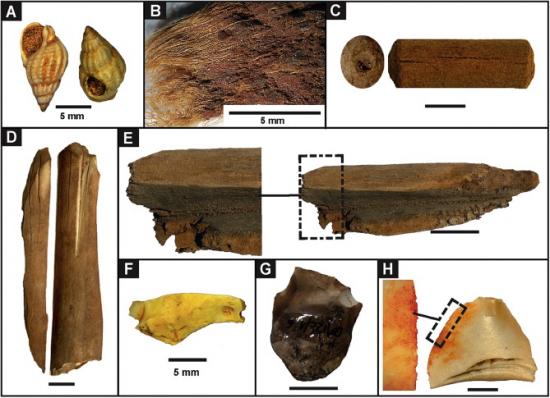
Fig. 7. Cultural remains found in stratigraphic context of QM12c (layers 2–4). A. Gastropod shell (cf. Nassarius gayi); B. Red mixture-coated plant fibers; C. Proximal fragment of a wooden artifact, shown in lateral and terminal views and part of an atlatl spear shaft fragment; D. Camelid bone with cut marks; E. Wooden artifact with prominent v-shaped longitudinal groove and other cultural modifications; F. Small biface fragment; G. Marginally-retouched scraper; H. Stained flake (with edge detail shown). All scale bars are 2.5 cm except where noted. (For interpretation of the references to color in this figure legend, the reader is referred to the web version of this article.)
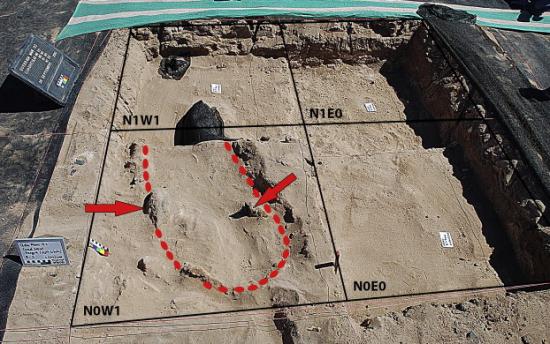
Fig. 8. Plane view of the prepared fireplace (dotted red line- Feature 4; layers 3 and 4, quad N0W1). The concave enclosure is delimited by a salt concretion along with a rock placed in vertical position with signs of burning and ash adherence (arrow on the left), and also by a wooden pointed stick that has been burned on its tip (arrow on the right). Grid N1W1 shows the location of two protected pedestals, one containing bone fragments and charcoal, and the other (facing the wall) contains the vertical-oriented wooden artifact (with a prominent v-shaped longitudinal groove, see Fig. 7E). The other grids (N0E0 and N1E0, also indicated) show the base of levels 4 and 5, respectively. (For interpretation of the references to color in this figure legend, the reader is referred to the web version of this article.)
Open Access Article